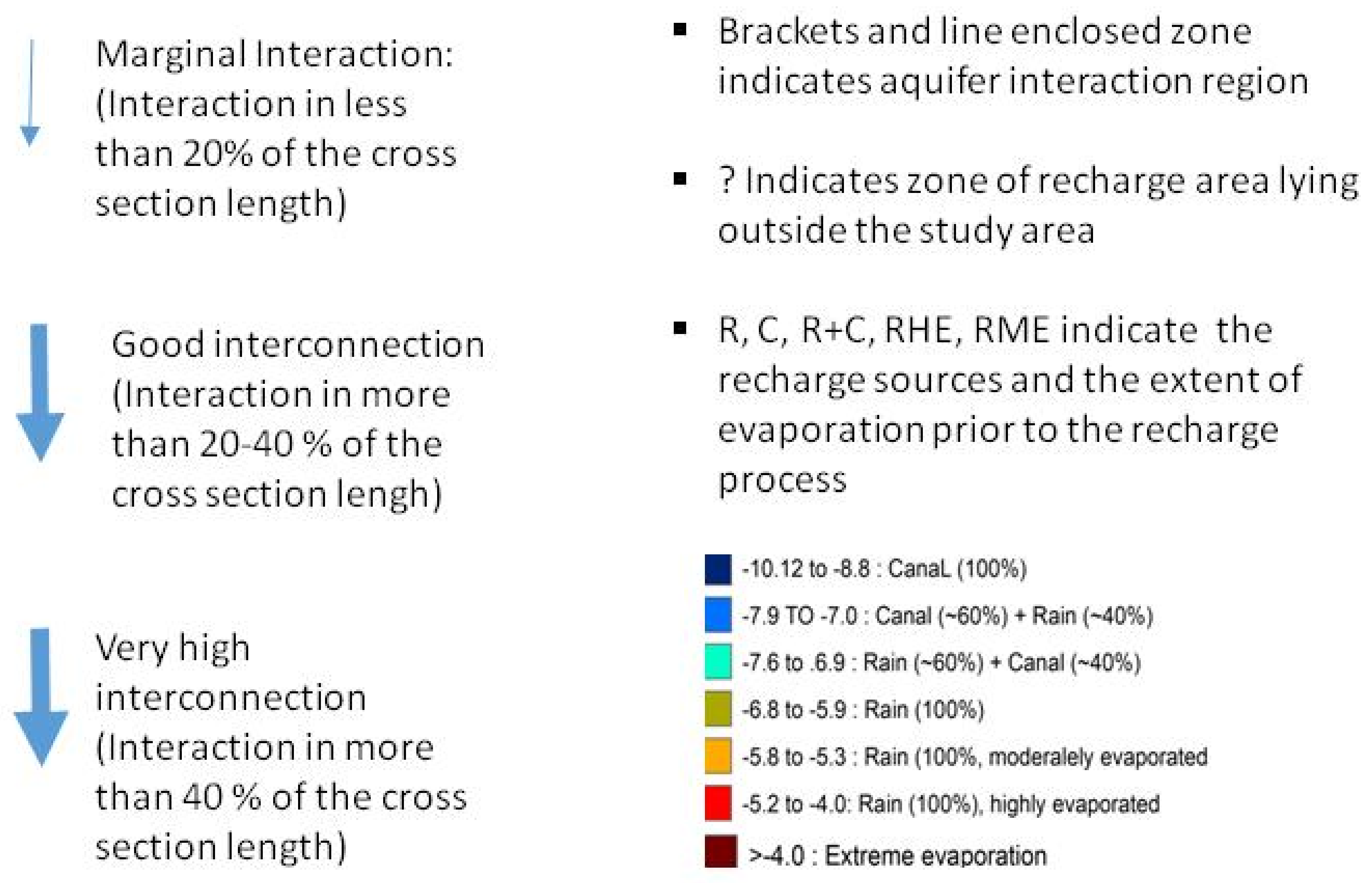Isotopic Assessment of Groundwater Salinity: A Case Study of the Southwest (SW) Region of Punjab, India
Abstract
:1. Introduction
2. Materials and Methods
2.1. Study Area
2.1.1. Demography
2.1.2. Hydrogeology and Climate
2.1.3. Agriculture and Irrigation
2.2. Methodologies Adopted
2.2.1. Piezometer Construction
2.2.2. Sampling and Analysis
Measurement and Analysis of Groundwater Salinity
Measurements of Stable Isotopes
3. Results and Discussion
3.1. Surface Topography
3.2. Land Use and Land Cover
3.3. Geomorphology and Surface Soil Features
3.4. Drainage
3.5. Groundwater Level Variations
3.6. Spatial and Depth-Wise Salinity Variations
3.7. Isotope Database of Groundwater and Its Analysis
3.7.1. Spatial Distribution of Isotope Values of Groundwater
3.7.2. Isotope Data Interpretation for Aquifer Interaction Studies
- On the basis of isotopic composition of groundwater, the source of recharge to the groundwater is designated as (i) canal (100%), (ii) canal (60%) + rain (40%), (iii) canal (40%) + rain (60%), (iv) rain (100%), (v) moderately evaporated rain, (vi) highly evaporated rain water, and (vii) extremely evaporated rain water.
- A similar isotopic composition of groundwater in the overlying and underlying aquifers indicates the recharge of the underlying aquifer from the overlying aquifer, indicating a semi-confined condition between them (in Figure 14, Figure 15 and Figure 16, the recharge from the overlying aquifer is shown by arrow marks).
- Non-similarity in the isotopic composition of groundwater in the overlying and underlying aquifers indicates that the recharging sources of the overlying and underlying aquifers are different (indicating a confined condition of the underlying aquifer). In Figure 14, Figure 15 and Figure 16, non-interconnectivity is shown by the “?” mark. This means that the underlying aquifer is getting recharged from areas lying outside the study area.
- The aquifers are considered to be marginally interactive if the commonality in isotopic signatures of the overlying and underlying aquifers is not more than 20% of the cross-sectional length.
- Interaction between the overlying and underlying aquifers is considered to be good if, isotopically, groundwater between these aquifers shows common signatures over 20% to 40% of the cross-sectional length.
- The underlying aquifer is considered to be recharging largely from the overlying aquifer if the isotopic signatures of the overlying and underlying aquifers are similar over more than 40% of the cross-section length.
4. Conclusions
Author Contributions
Funding
Institutional Review Board Statement
Informed Consent Statement
Data Availability Statement
Acknowledgments
Conflicts of Interest
References
- Bonsor, H.C.; MacDonald, A.M.; Ahmed, K.M.; Burgess, W.G.; Basharat, M.; Calow, R.C.; Dixit, A.; Foster, S.S.D.; Gopal, K.; Lapworth, D.J.; et al. Hydrogeological typologies of the Indo-Gangetic basin alluvial aquifer, South Asia. Hydrogeol. J. 2017, 25, 1377–1406. [Google Scholar] [CrossRef] [Green Version]
- Rodell, M.; Velicogna, I.; Famiglietti, J.S. Satellite-based estimates of groundwater depletion in India. Nature 2009, 460, 999–1002. [Google Scholar] [CrossRef] [PubMed] [Green Version]
- NASA. Study: Third of Big Groundwater Basins in Distress. 2015. Available online: https://www.nasa.gov/jpl/grace/study-third-of-big-groundwater-basins-in-distress (accessed on 27 December 2020).
- MacDonald, A.M.; Bonsor, H.C.; Ahmed, K.M.; Burgess, W.G.; Basharat, M.; Calow, R.C.; Dixit, A.; Foster, S.S.; Gopal, K.; Lapworth, D.J.; et al. Groundwater depletion and quality in the Indo-Gangetic basin mapped from in situ observations. Nat. Geosci. 2016, 9, 762–766. [Google Scholar] [CrossRef]
- Custodio, E. Coastal aquifer salinization as a consequence of aridity: The case of Amurga phonolitic massif, Gran Canaria Island, in Study and Modelling of Saltwater Intrusion. In Proceedings of the 12th Saltwater Intrusion Meeting, Barcelona, Spain, First Week of November 1992; pp. 81–98. [Google Scholar]
- Krishan, G.; Ghosh, N.C.; Kumar, C.P.; Sharma, M.; Yadav, L.; Kansal, M.L.; Singh, S.; Verma, S.K.; Prasad, G. Understanding stable isotope systematics of salinity affected groundwater in Mewat, Haryana, India. J. Earth Syst. Sci. 2020, 129, 109. [Google Scholar] [CrossRef]
- Gopinath, S.; Srinivasamoorthy, K.; Saravanan, K.; Prakash, R. Tracing groundwater salinization using geochemical and isotopic signature in Southeastern coastal Tamilnadu, India. Chemosphere 2019, 236, 124305. [Google Scholar] [CrossRef]
- Bennetts, D.A.; Webb, J.A.; Stone, D.J.M.; Hill, D.M. Understanding the salinisation process for groundwater in an area of south-eastern Australia, using hydrochemical and isotopic evidence. J. Hydrol. 2006, 323, 178–192. [Google Scholar] [CrossRef]
- Jouzel, J.; Delaygue, G.; Landais, A.; Masson-Delmotte, V.; Risi, C.; Vimeux, F. Water isotopes as tools to document oceanic sources of precipitation. Water Resour. Res. 2013, 49, 7469–7486. [Google Scholar] [CrossRef]
- Argamasilla, M.; Barber’a, J.A.; Andreo, B. Factors controlling groundwater salinization and hydrogeochemical processes in coastal aquifers from southern Spain. Sci. Total Environ. 2017, 580, 50–68. [Google Scholar] [CrossRef]
- Krishan, G.; Prasad, G.; Kumar, C.P.; Patidar, N.; Yadav, B.K.; Kansal, M.L.; Singh, S.; Sharma, L.M.; Bradley, A.; Verma, S.K. Identifying the seasonal variability in source of groundwater salinization using deuterium excess—A case study from Mewat, Haryana, India. J. Hydrol. Reg. Stud. 2020, 31, 100724. [Google Scholar] [CrossRef]
- Appelo, C.; Postma, D. Geochemistry, Groundwater and Pollution, 2nd ed.; Balkema: Rotterdam, The Netherlands, 2005. [Google Scholar] [CrossRef]
- Adimalla, N. Groundwater Quality for Drinking and Irrigation Purposes and Potential Health Risks Assessment: A Case Study from Semi-Arid Region of South India. Expo. Health 2019, 11, 109–123. [Google Scholar] [CrossRef]
- Singh, S.; Kumar, A.; Gupta, H. Activated banana peel carbon: A potential adsorbent for Rhodamine B decontamination from aqueous system. Appl. Water Sci. 2020, 10, 185. [Google Scholar] [CrossRef]
- Kumar, A.; Jigyasu, D.K.; Subrahmanyam, G.; Mondal, R.; Shabnam, A.A.; Cabral-Pinto, M.M.S.; Malyan, S.K.; Chaturvedi, A.K.; Gupta, D.K.; Fagodiya, R.K.; et al. Nickel in terrestrial biota: Comprehensive review on contamination, toxicity, tolerance and its remediation approaches. Chemosphere 2021, 275, 129996. [Google Scholar] [CrossRef]
- Kumar, A.; Pinto, M.C.; Candeias, C.; Dinis, P.A. Baseline maps of potentially toxic elements on soils of Garhwal Himalaya, India: Assessment of their eco-environmental and human health risks. Land Degrad. Dev. 2021, 32, 3856–3869. [Google Scholar] [CrossRef]
- Houéménou, H.; Tweed, S.; Dobigny, G.; Mama, D.; Alassane, A.; Silmer, R.; Babic, M.; Ruy, S.; Chaigneau, A.; Gauthier, P.; et al. Degradation of groundwater quality in expanding cities in West Africa. A case study of the unregulated shallow aquifer in Cotonou. J. Hydrol. 2020, 582, 124438. [Google Scholar] [CrossRef]
- Modibo Sidibé, A.; Lin, X.; Koné, S. Assessing Groundwater Mineralization Process, Quality, and Isotopic Recharge Origin in the Sahel Region in Africa. Water 2019, 11, 789. [Google Scholar] [CrossRef] [Green Version]
- Krishan, G.; Sudersan, N.; Sidhu, B.S.; Vashisth, R. Impact of lockdown due to COVID 19 pandemic on Groundwater salinity in Punjab, India: Some hydrogeoethics issues. Sustain. Groundw. Resour. Manag. 2021, 7, 27. [Google Scholar] [CrossRef] [PubMed]
- Krishan, G.; Taloor, A.K.; Sudarsan, N.; Bhattacharya, P.; Kumar, S.; Ghosh, N.C.; Singh, S.; Sharma, A.; Rao, M.S.; Mittal, S.; et al. Occurrences of potentially toxic trace metals in groundwater of the state of Punjab in northern India. Groundw. Sustain. Dev. 2021, 15, 100655. [Google Scholar] [CrossRef]
- Krishan, G.; Kumar, B.; Sudarsan, N.; Rao, M.S.; Ghosh, N.C.; Taloor, A.K.; Bhattacharya, P.; Singh, S.; Kumar, C.P.; Sharma, A.; et al. Isotopes (δ18O, δD and 3H) variations in groundwater with emphasis on salinization in the State of Punjab, India. Sci. Total Environ. 2021, 789, 148051. [Google Scholar] [CrossRef]
- Krishan, G.; Vashisth, R.; Sudersan, N.; Rao, M.S. Groundwater salinity and isotope characterization: A case study from south-west Punjab, India. Environ. Earth Sci. 2021, 80, 169. [Google Scholar] [CrossRef]
- Yehdeghoa, B.; Rozanski, K.; Zojer, H.; Stichler, W. Interaction of dredging lakes with the adjacent groundwater field: An isotope study. J. Hydrol. 1997, 192, 247–270. [Google Scholar] [CrossRef]
- Wang, W.; Yi, Y.; Zhong, J.; Kumar, A.; Li, S.L. Carbon biogeochemical processes in a subtropical karst river–reservoir system. J. Hydrol. 2020, 591, 125590. [Google Scholar] [CrossRef]
- Bhat, M.A.; Zhong, J.; Dar, T.; Kumar, A.; Li, S.L. Spatial distribution of stable isotopes in surface water on the upper Indus River basin (UIRB): Implications for moisture source and paleoelevation reconstruction. Appl. Geochem. 2022, 136, 105137. [Google Scholar] [CrossRef]
- Kumar, R.; Rani, M.; Gupta, H.; Gupta, B.; Park, D.; Jeon, B.H. Distribution of trace elements in flowing surface waters: Effect of seasons and anthropogenic practices in India. Int. J. Environ. Anal. Chem. 2017, 97, 637–656. [Google Scholar] [CrossRef]
- Dansgaard, W. Stable isotopes in precipitation. Tellus 1994, 16, 436–468. [Google Scholar]
- Zhu, L.; Fan, M.; Hough, B.; Li, L. Spatiotemporal distribution of river water stable isotope compositions and variability of lapse rate in the central Rocky Mountains: Controlling factors and implications for paleoelevation reconstruction. Earth Planet. Sci. Lett. 2018, 496, 215–226. [Google Scholar] [CrossRef]
- Nayak, P.C.; Kumar, S.V.; Rao, P.R.; Vijay, T. Recharge source identification using isotope analysis and groundwater flow modeling for Puri city in India. Appl. Water Sci. 2017, 7, 3583–3598. [Google Scholar] [CrossRef] [Green Version]
- Ahmed, I.M.; Jalludin, M.; Razack, M. Hydrochemical and Isotopic Assessment of Groundwater in the Goda Mountains Range System. Republic of Djibouti (Horn of Africa). Water 2020, 12, 2004. [Google Scholar] [CrossRef]
- CENSUS. 2011. Available online: http://www.census2011.co.in/census/district/226-mewat.html (accessed on 13 January 2021).
- CGWB. Aquifer Mapping and Management Plan, North Western Region. Central Groundwater Board, Ministry of Water Resources; Government of India: Chandigarh, India, 2017.
- CGWB, Goverment of India. Groundwater Resources of Punjab State—As on 31st March, 2017—Prepared by CGWB-NWR and Water Resources and Environment Directorate; Government of Punjab: Punjab, India, 2018; p. 176.
- APHA. Standard Methods for the Examination of Water and Waste Water, 22nd ed.; American Public Health Association: Washington, DC, USA; American Water Works Association: Denver, CO, USA; Water Environment Federation: Virginia, VA, USA, 2012. [Google Scholar]
- Kumar, A.; Taxak, A.K.; Mishra, S.; Pandey, R. Long term trend analysis and suitability of water quality of River Ganga at Himalayan hills of Uttarakhand, India. Environ. Technol. Innov. 2021, 22, 101405. [Google Scholar] [CrossRef]
- Van Weert, F.; Van der Gun, J.; Reckman, J. Global Overview of Saline Groundwater Occurrence and Genesis; IGRAC: Utrecht, The Netherlands, 2009. [Google Scholar]
- IS: 10500; Specifications for Drinking Water. Bureau of Indian Standards: New Delhi, India, 2012.
- Krishan, G.; Rao, M.S. Isotope Hydrology; Lambert Publishing House: Saarbrücken, Germany, 2013; p. 513. [Google Scholar]
- Lapworth, D.J.; Krishan, G.; MacDonald, A.M.; Rao, M.S. Groundwater quality in the alluvial aquifer system of northwest India: New evidence of the extent of anthropogenic and geogenic contamination. Sci. Total Environ. 2017, 599, 1433–1444. [Google Scholar] [CrossRef] [Green Version]
- Carol, E.; Kruse, E.; Mas-Pla, J. Hydrochemical and isotopical evidence of ground water salinization processes on the coastal plain of Samborombón Bay, Argentina. J. Hydrol. 2009, 365, 335–345. [Google Scholar] [CrossRef]
- Gibbs, R.J. Mechanisms controlling world water chemistry. Science 1970, 170, 1088–1090. [Google Scholar] [CrossRef] [PubMed]
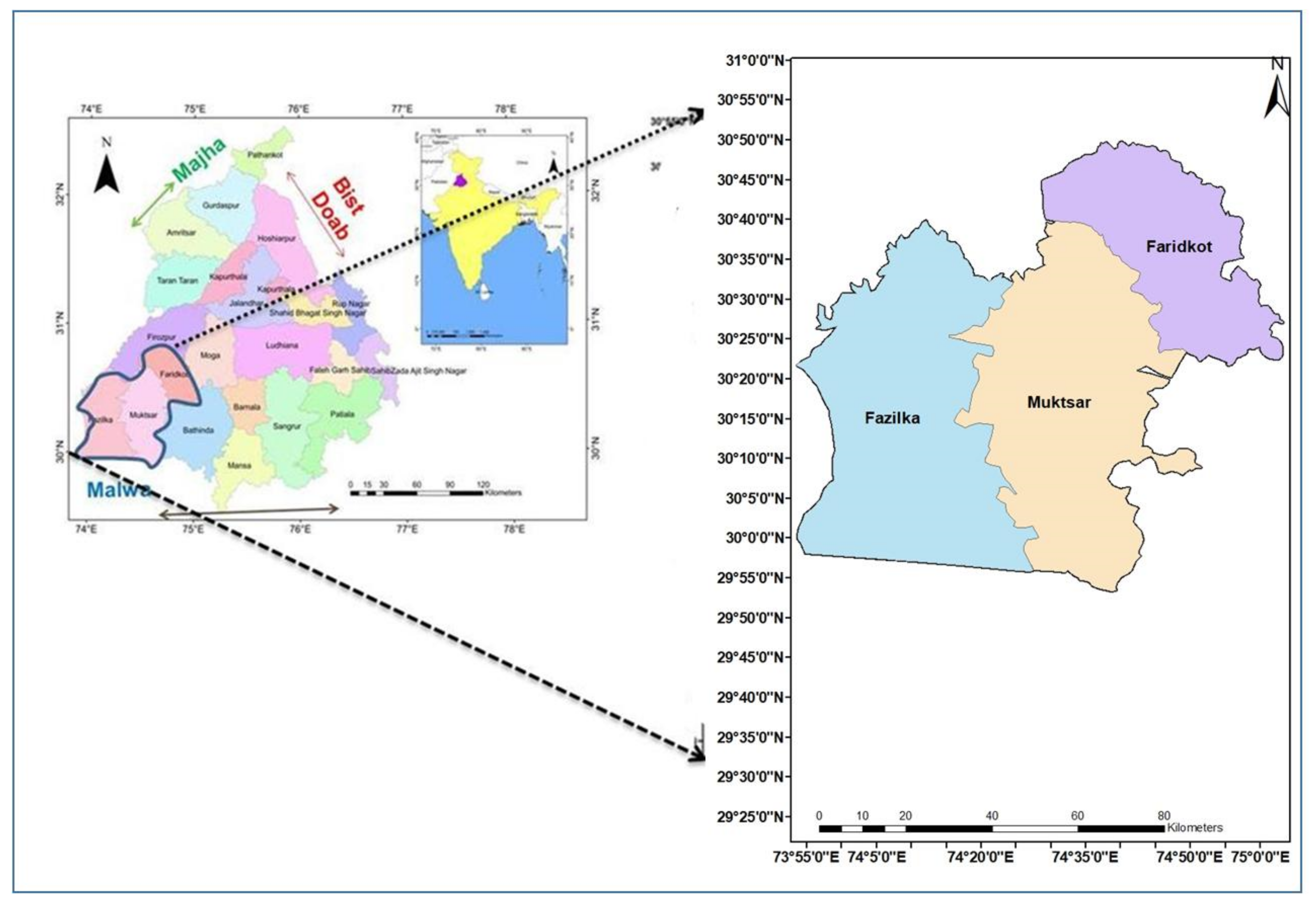
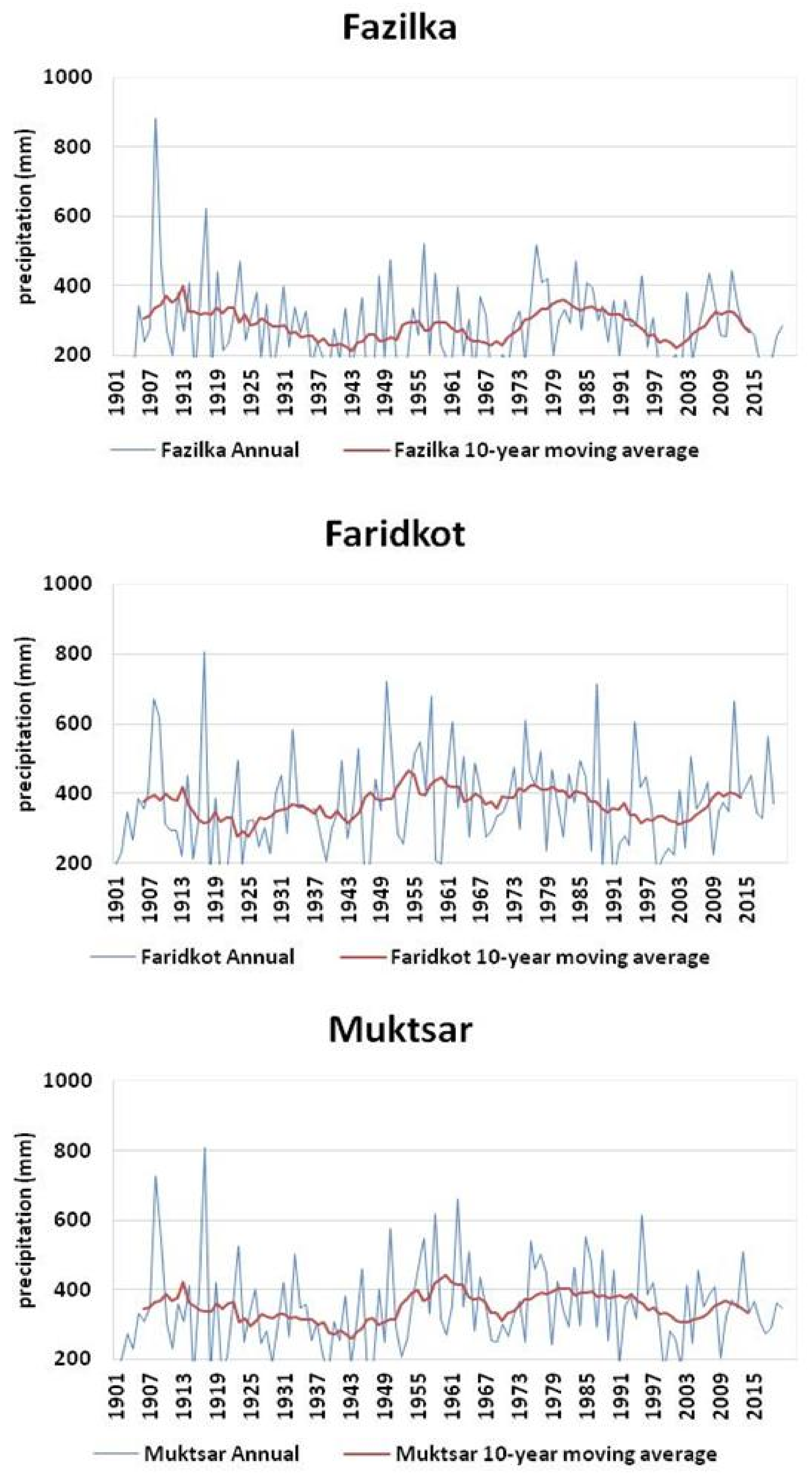
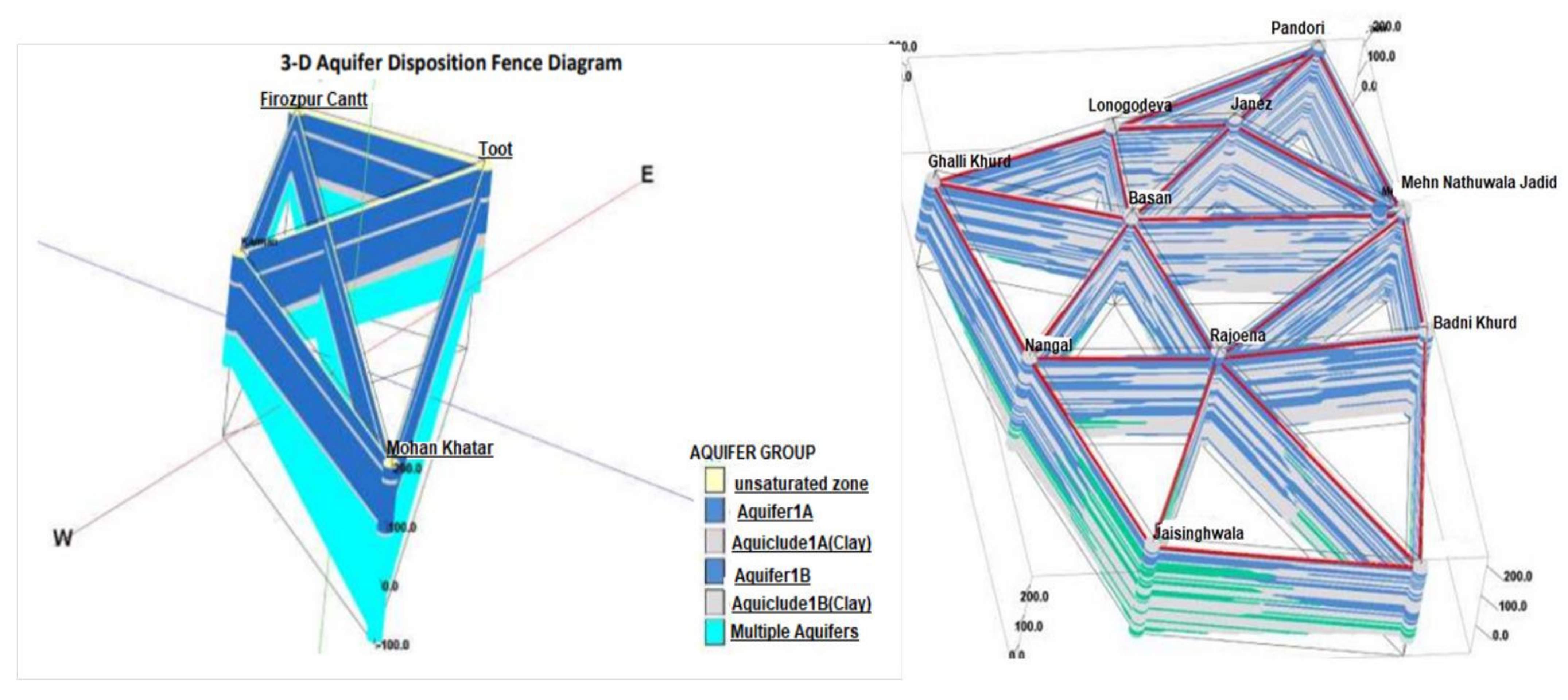
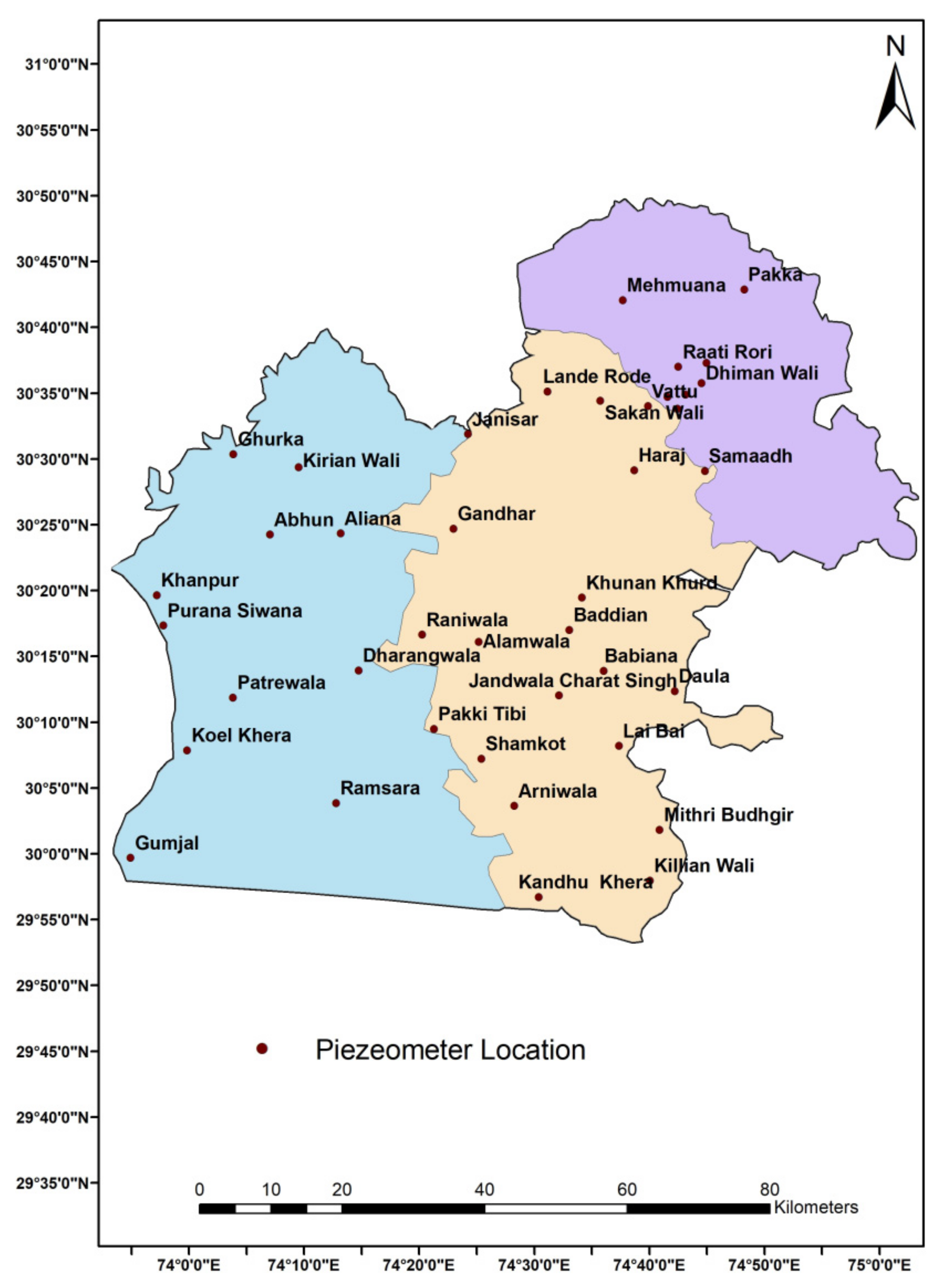
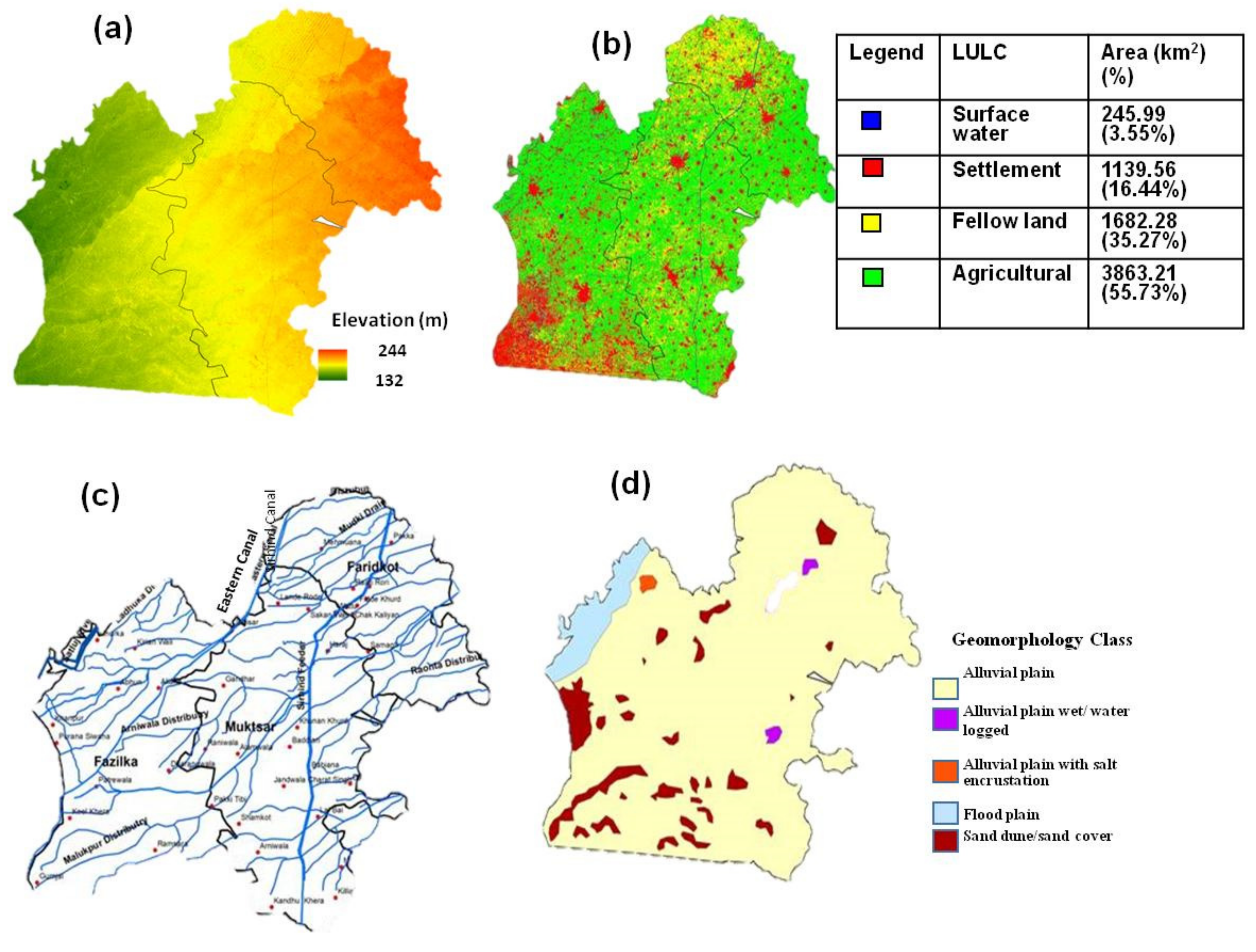
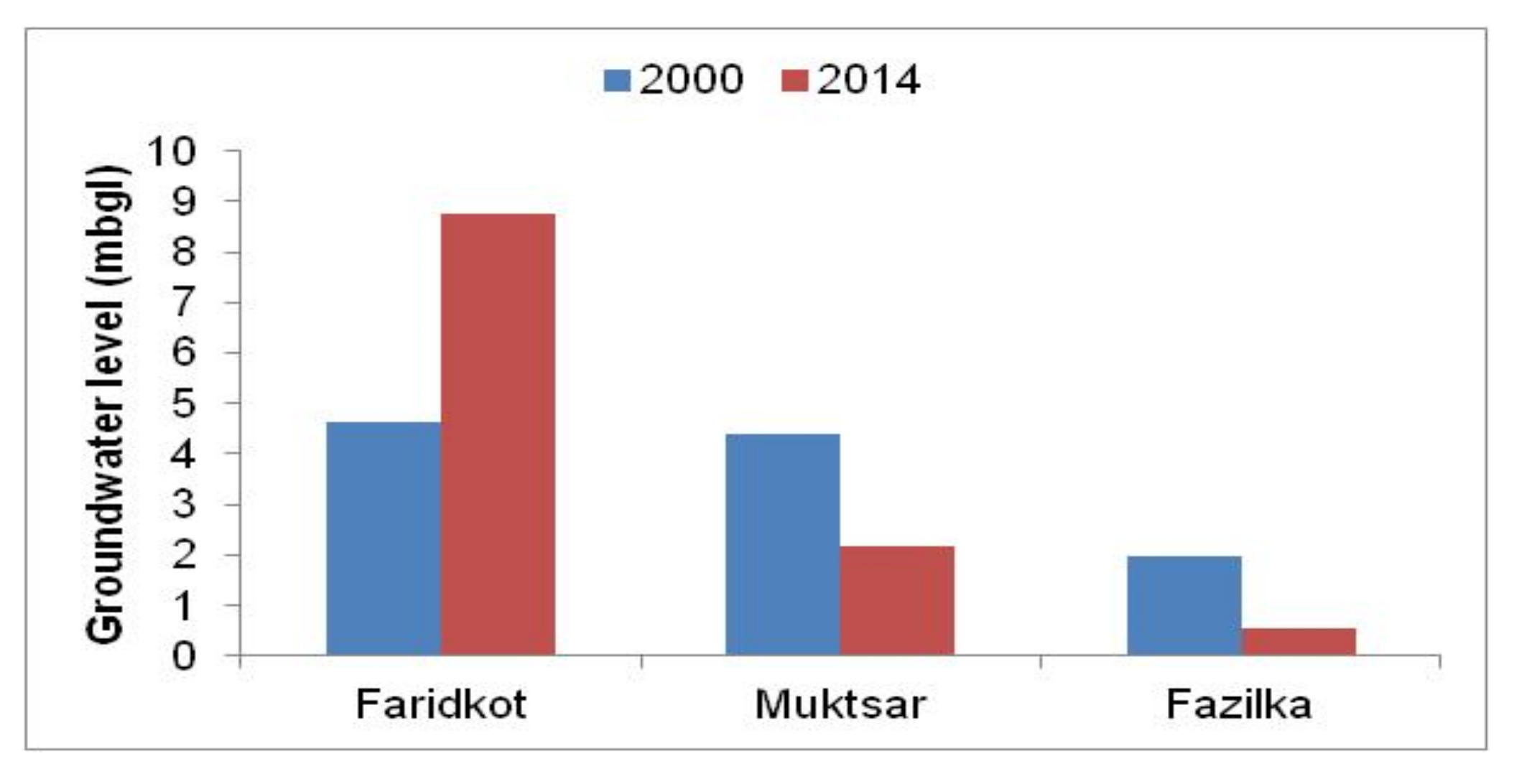
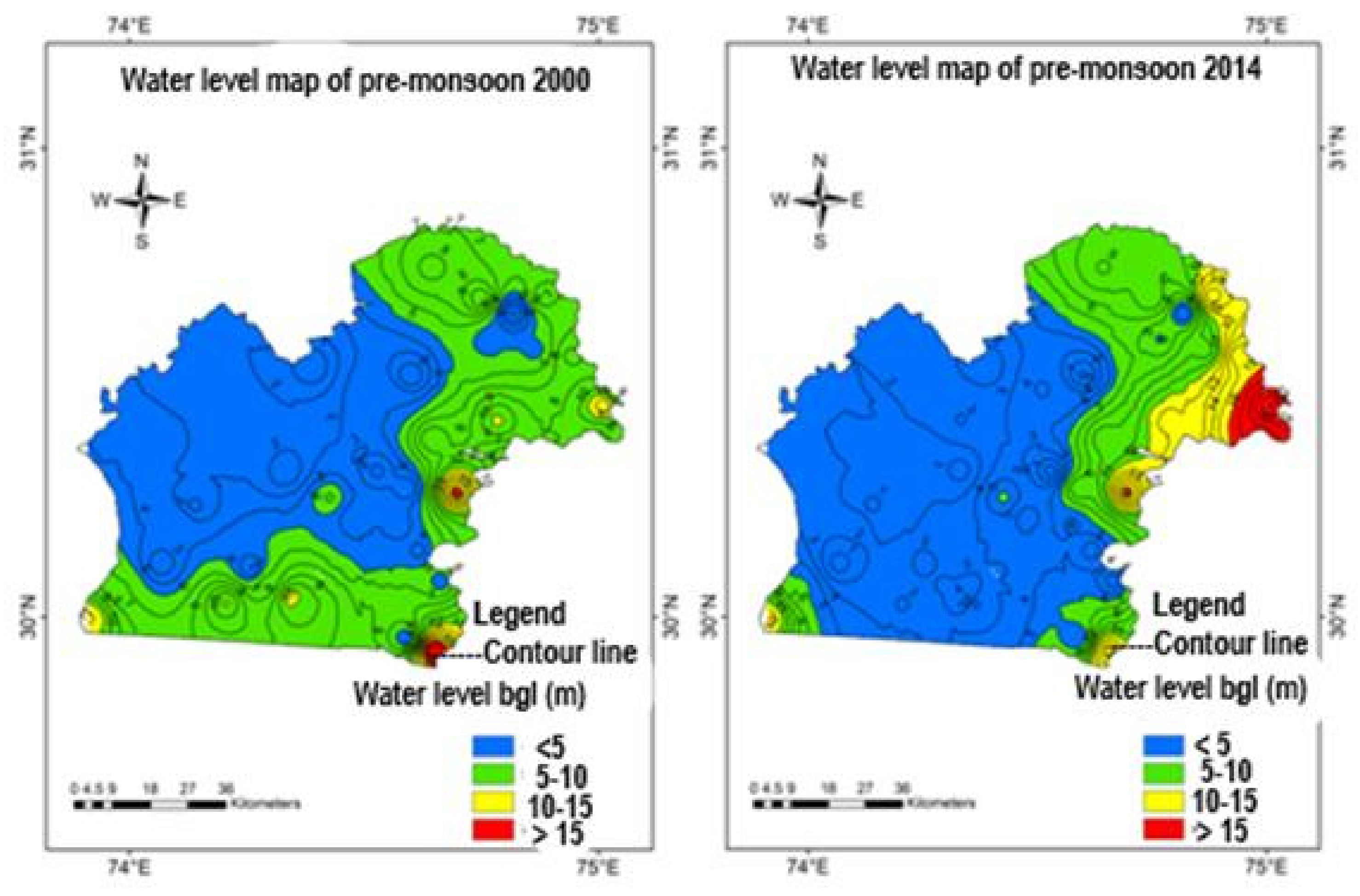
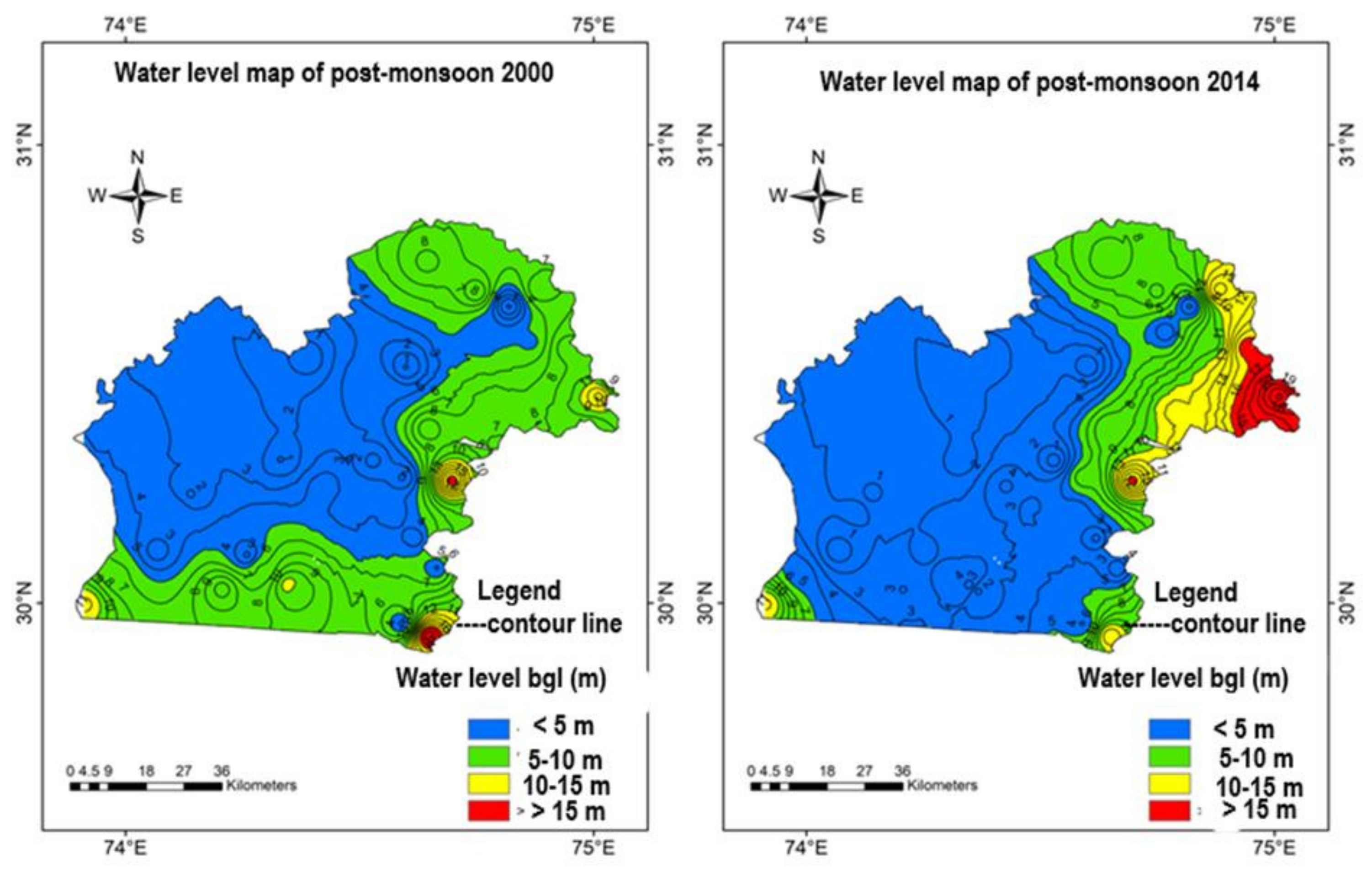
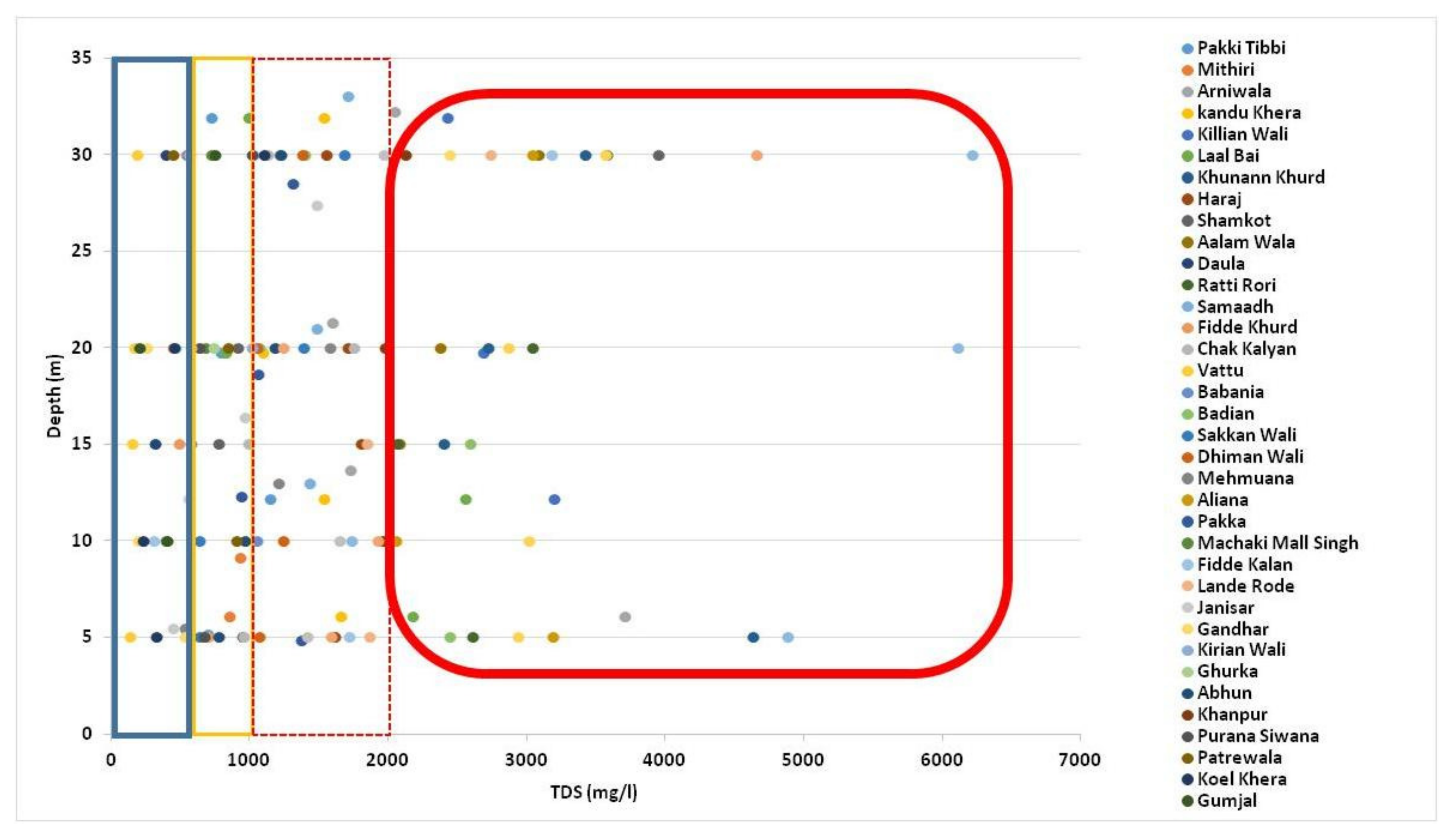
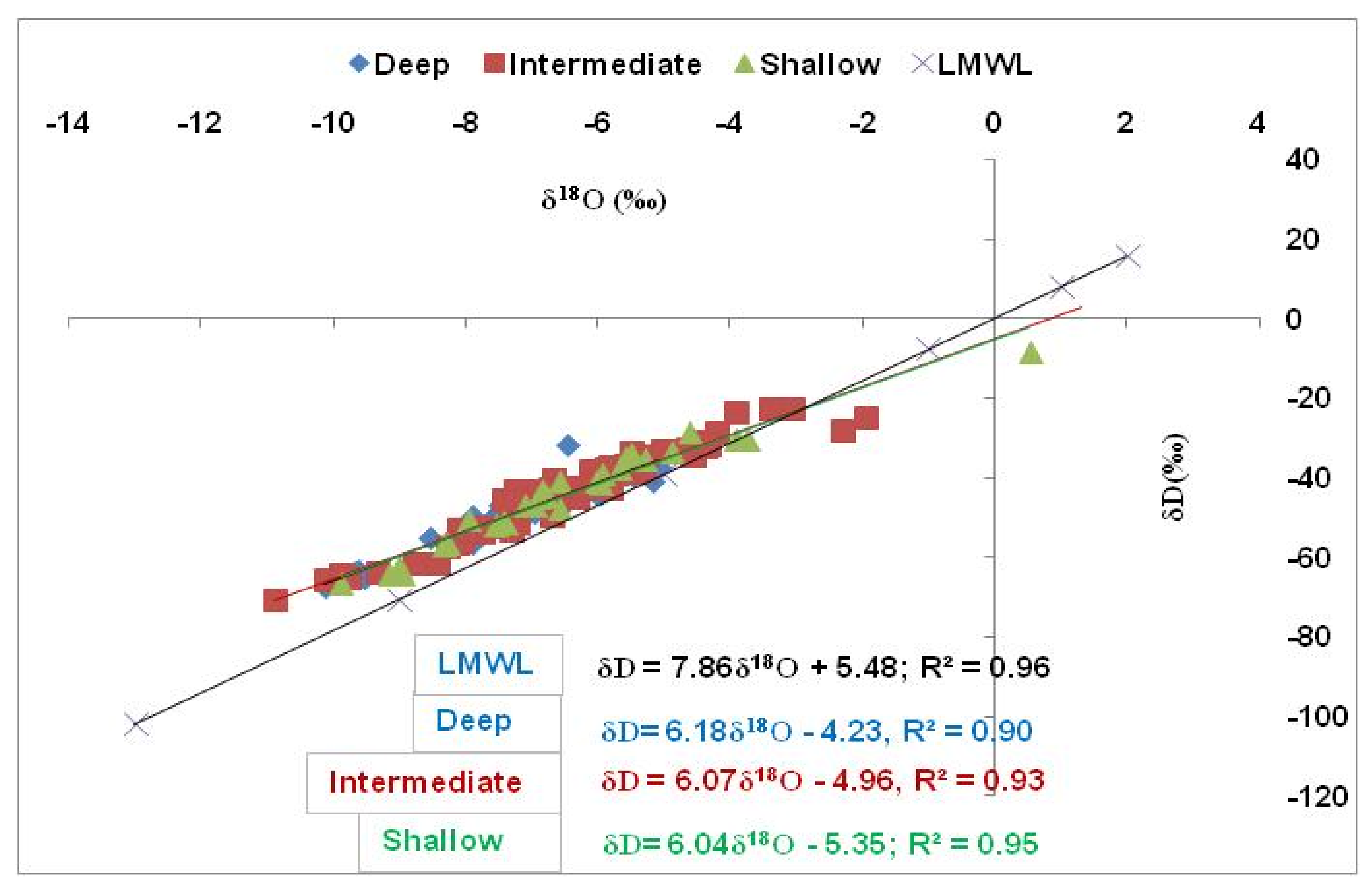
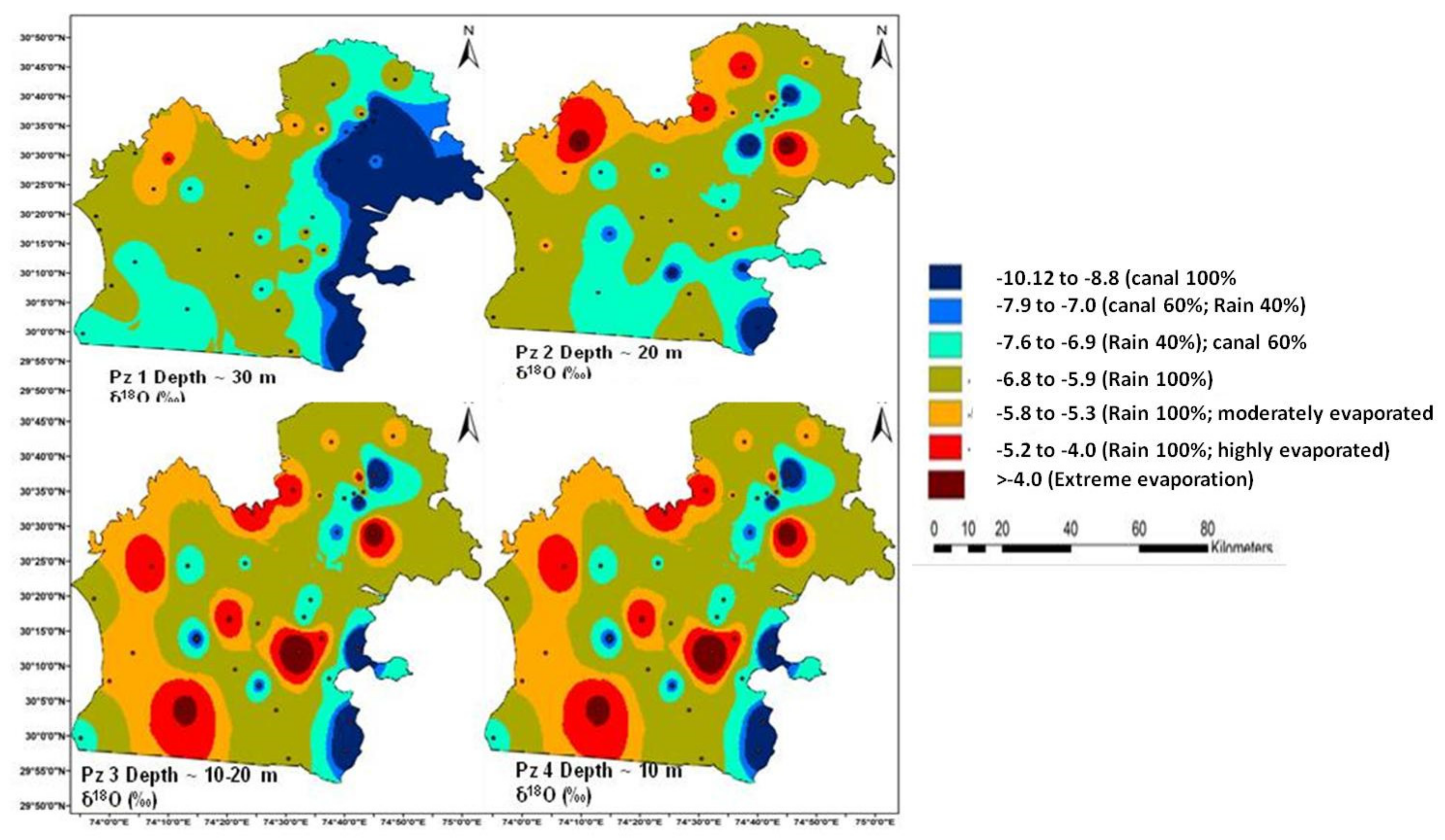
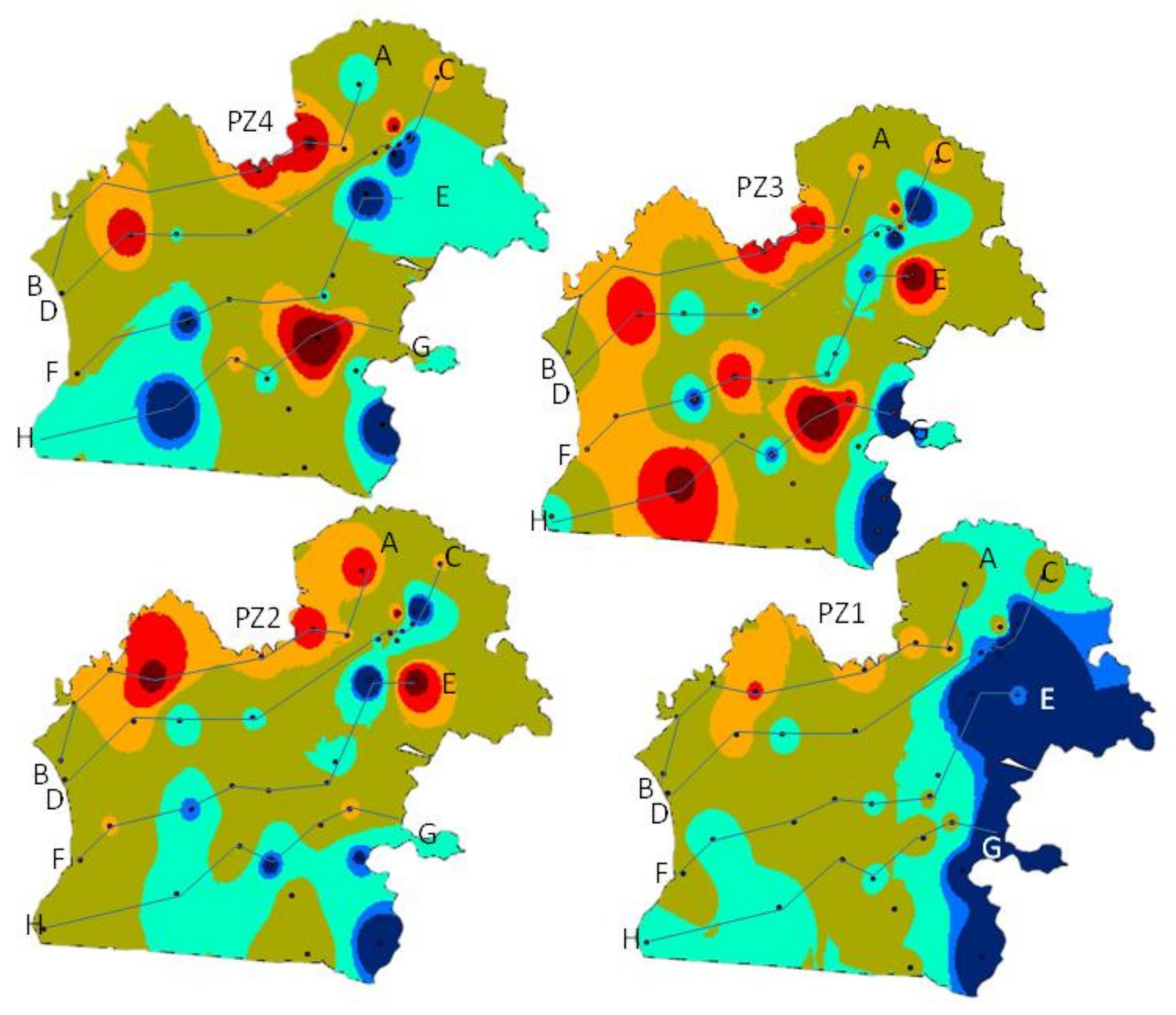
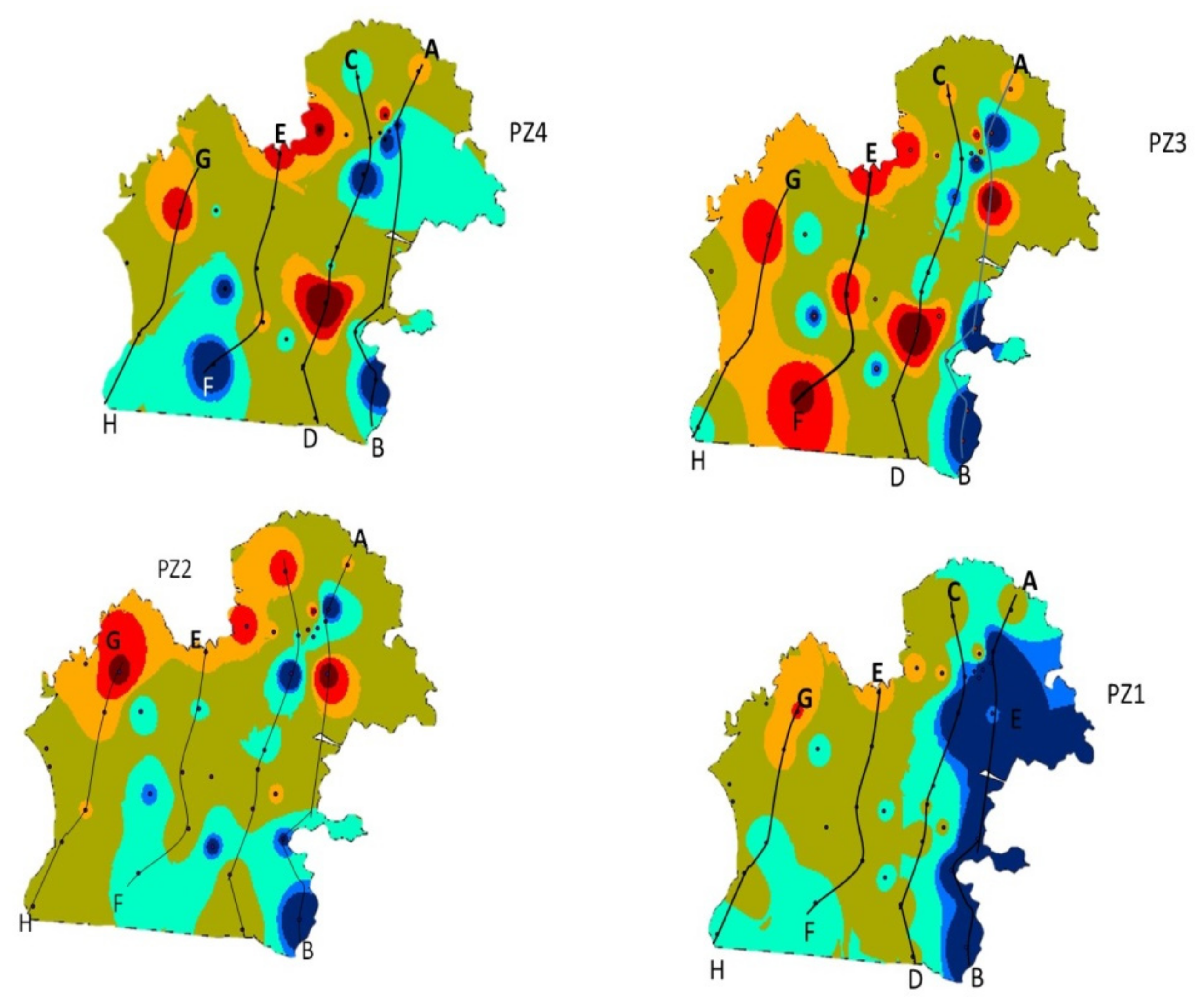
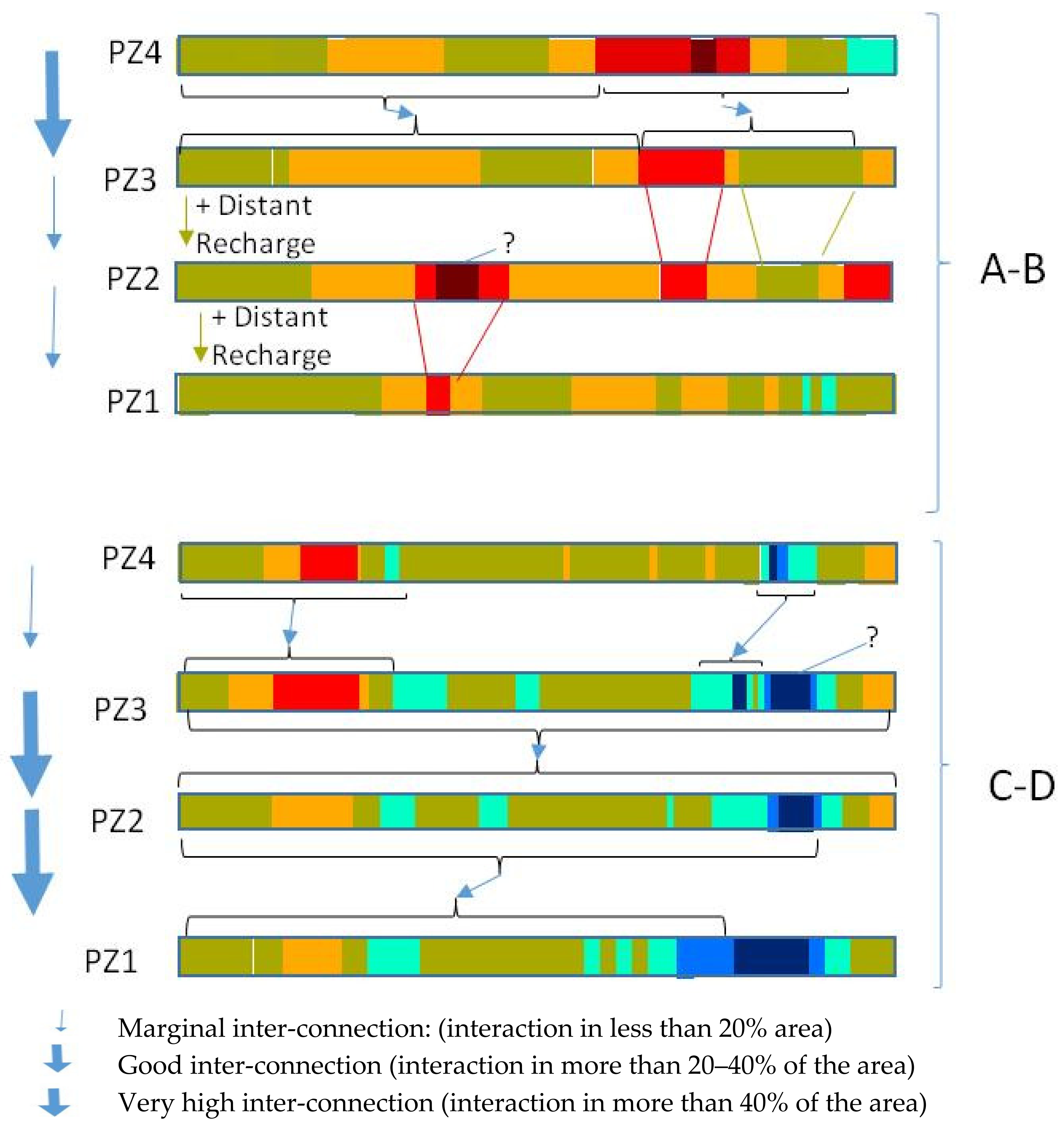
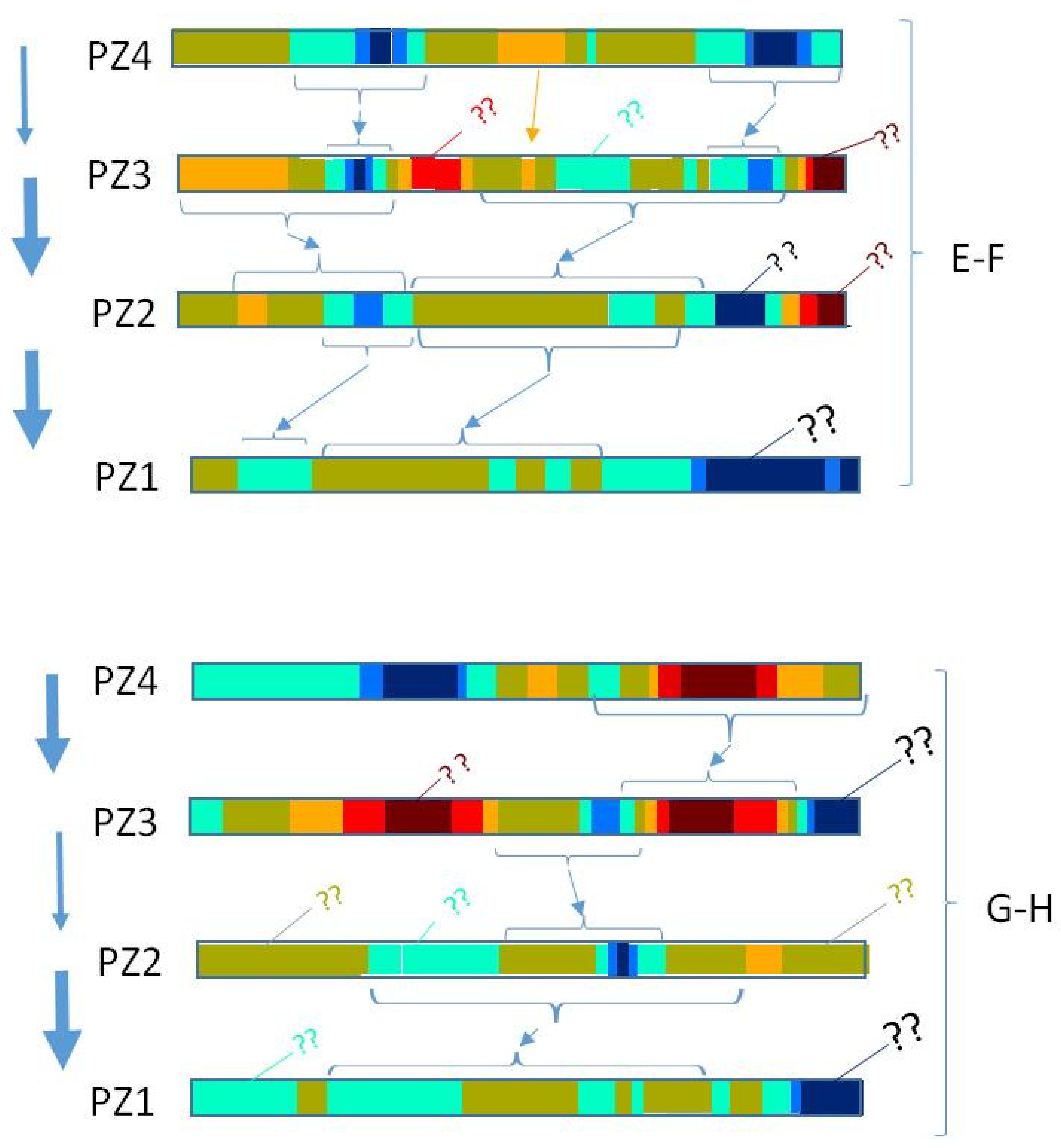
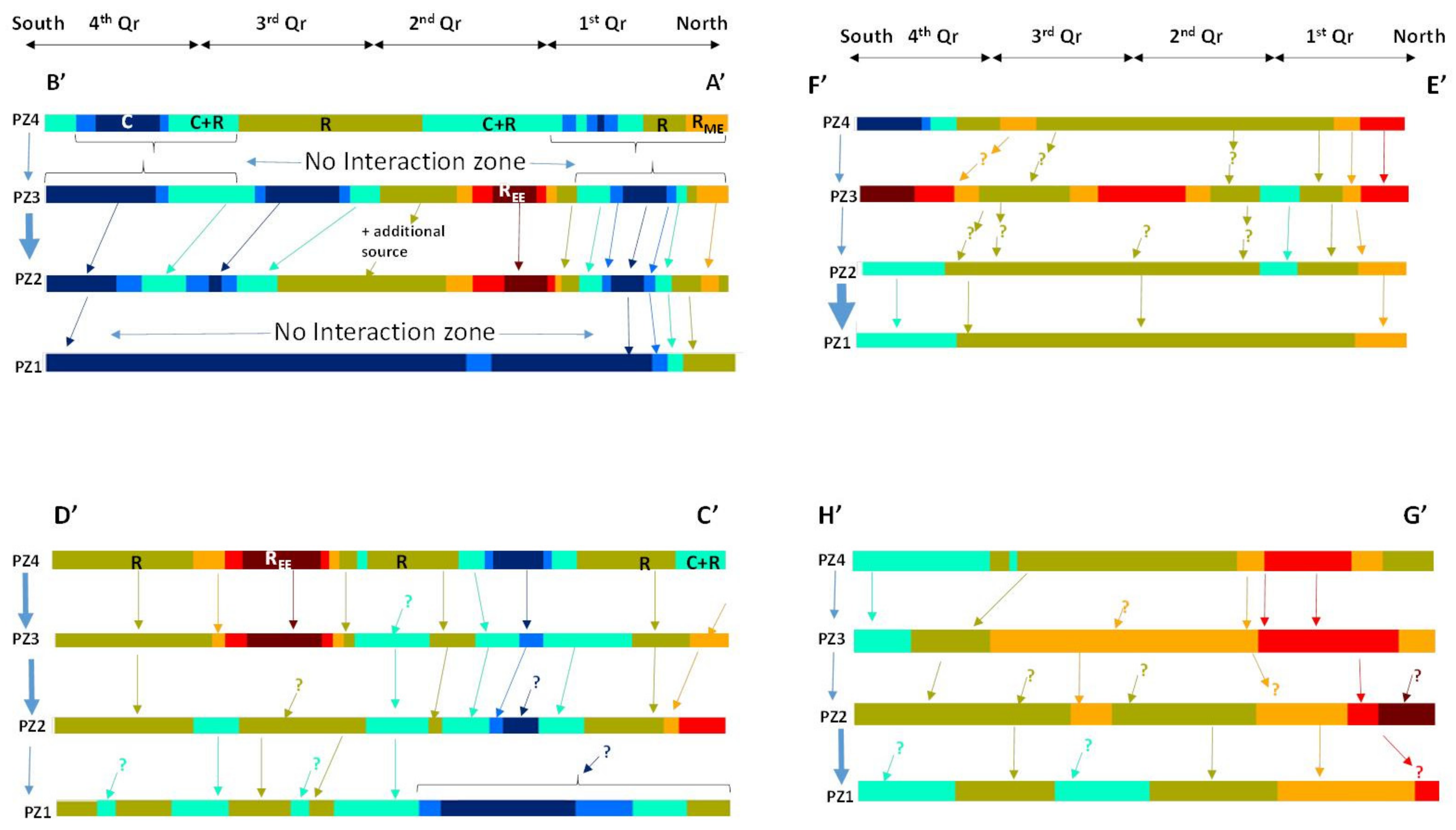
| Source | Equation (Calculated from Monthly Weighted Average) | Range (δ18O; δD) |
|---|---|---|
| GMWL (Rozanski et al., 1993) | δD = 8.17 δ18O + 10.35 | -- |
| Precipitation (Dolbaha) (Krishan et al., 2021) | δD = 7.9 δ18O + 5.48; R2 = 0.96; n = 322 | 10.9, −15; 67.5, −117.3 |
| River Sutlej (Krishan et al., 2021) | δD = 7.2 δ18O + 0.16; R2 = 0.96; n = 51 | 0.15, −12.6; −18.6, −90.7 |
| Canal (Krishan et al., 2021) | δD = 6.8 δ18O + 0.38; R2 = 0.97; | −6.06, −10.9; −42.7, −74.5 |
| Groundwater (Deep ~30 m) | δD = 6.2 δ18O − 4.2; R2 = 0.90; n = 142 | −5.09, −10.1; −31.9, −67.6 |
| Groundwater (Intermediate 10–20 m) | δD = 6.1 δ18O − 5.0; R2 = 0.93; n = 142 | −1.3, −10.9; −22.6, −71 |
| Groundwater (Shallow ~<10 m) | δD = 6.0 δ18O − 5.4; R2 = 0.95; n = 142 | 0.5, −9.9; −8.9, −66.6 |
| Groundwater Recharge Source (Code: Canal (C); Rain (R)) | Isotopic Range (‰) | Aquifer Area Covered (%) at Different Depths | |||
|---|---|---|---|---|---|
| PZ4 (<5 m) | PZ3 (~10 m) | PZ2 (~20 m) | PZ1 (~30 m) | ||
| C (100%) | −10.12 to −8.8 | 18.96 | 2.33 | 3.13 | 3.68 |
| C (60%) + Rain (40%) | −7.9 to −7.0 | 4.83 | 1.78 | 1.59 | 2.68 |
| R (60%) + C (40%) | −6.6 to −6.9 | 26.47 | 21.82 | 11.18 | 27.11 |
| R (100%) | −6.8 to −5.9 | 43.01 | 55.23 | 49.31 | 51.41 |
| Moderately evaporated rain water | −5.8 to −5.3 | 6.56 | 12.88 | 22.02 | 9.24 |
| Highly evaporated rain water | −5.2 to −4.0 | 0.17 | 5.13 | 10.59 | 4.47 |
| Extremely highly evaporated rain water | >−4.0 | 0.00 | 0.84 | 2.17 | 1.41 |
| Cross Section | Aquifer | Level of Inter-Connectivity in the Segment Zones 1 to 4 | |||
|---|---|---|---|---|---|
| 1 | 2 | 3 | 4 | ||
| A–B | PZ4 to PZ3 | Moderate | Nil | Nil | Moderate |
| PZ3 to PZ2 | Very Good | Moderate | Low | Moderate | |
| PZ2 to PZ1 | Low | Nil | Nil | Very low | |
| C–D | PZ4 to PZ3 | Low | Moderate | Good | Very good |
| PZ3 to PZ2 | Moderate | Good | Nil | Very good | |
| PZ2 to PZ1 | Nil | Low | Low | Moderate | |
| E–F | PZ4 to PZ3 | Good | Nil | Nil | Nil |
| PZ3 to PZ2 | Moderate | Very low | Very low | Very low | |
| PZ2 to PZ1 | Moderate | Very good | Very good | Very good | |
| G–H | PZ4 to PZ3 | Moderate | Very low | Nil | Moderate |
| PZ3 to PZ2 | Very low | Very low | Moderate | Moderate | |
| PZ2 to PZ1 | Moderate | Good | Low | Very low | |
Publisher’s Note: MDPI stays neutral with regard to jurisdictional claims in published maps and institutional affiliations. |
© 2022 by the authors. Licensee MDPI, Basel, Switzerland. This article is an open access article distributed under the terms and conditions of the Creative Commons Attribution (CC BY) license (https://creativecommons.org/licenses/by/4.0/).
Share and Cite
Krishan, G.; Rao, M.S.; Vashisht, R.; Chaudhary, A.; Singh, J.; Kumar, A. Isotopic Assessment of Groundwater Salinity: A Case Study of the Southwest (SW) Region of Punjab, India. Water 2022, 14, 133. https://doi.org/10.3390/w14010133
Krishan G, Rao MS, Vashisht R, Chaudhary A, Singh J, Kumar A. Isotopic Assessment of Groundwater Salinity: A Case Study of the Southwest (SW) Region of Punjab, India. Water. 2022; 14(1):133. https://doi.org/10.3390/w14010133
Chicago/Turabian StyleKrishan, Gopal, Mavidanam Someshwar Rao, Rajesh Vashisht, Anju Chaudhary, Jaswant Singh, and Amit Kumar. 2022. "Isotopic Assessment of Groundwater Salinity: A Case Study of the Southwest (SW) Region of Punjab, India" Water 14, no. 1: 133. https://doi.org/10.3390/w14010133
APA StyleKrishan, G., Rao, M. S., Vashisht, R., Chaudhary, A., Singh, J., & Kumar, A. (2022). Isotopic Assessment of Groundwater Salinity: A Case Study of the Southwest (SW) Region of Punjab, India. Water, 14(1), 133. https://doi.org/10.3390/w14010133







